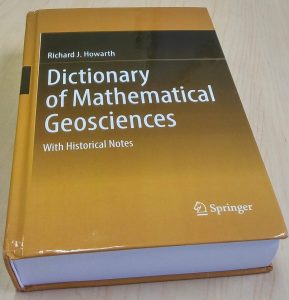 A book review was recently published in Mathematical Geosciences.
A book review was recently published in Mathematical Geosciences.
You can find it and download it here.

 A book review was recently published in Mathematical Geosciences.
A book review was recently published in Mathematical Geosciences.
You can find it and download it here.
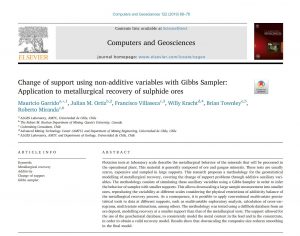 Another paper published in Computers & Geosciences. You can download it here.
Another paper published in Computers & Geosciences. You can download it here.
Mauricio Garrido (ALGES Laboratory, AMTC, Universidad de Chile, Chile), Julian M. Ortiz (The Robert M. Buchan Department of Mining, Queen’s University, Canada), Francisco Villaseca (Codemining Consultant, Chile), Willy Kracht (Advanced Mining Technology Center (AMTC) and Department of Mining Engineering, Universidad de Chile, Chile), Brian Townley (ALGES Laboratory, AMTC and Department of Geology, Universidad de Chile, Chile), Roberto Miranda (Codemining Consultant, Chile)
Abstract
Flotation tests at laboratory scale describe the metallurgical behavior of the minerals that will be processed in the operational plant. This material is generally composed of ore and gangue minerals. These tests are usually scarce, expensive and sampled in large supports. This research proposes a methodology for the geostatistical modelling of metallurgical recovery, covering the change of support problems through additive auxiliary variables. The methodology consists of simulating these auxiliary variables using a Gibbs Sampler in order to infer the behavior of samples with smaller supports. This allows downscaling a large sample measurement into smaller ones, reproducing the variability at different scales considering the physical restrictions of additivity balance of the metallurgical recovery process. As a consequence, it is possible to apply conventional multivariate geostatistical tools to data at different supports, such as multivariable exploratory analysis, calculation of cross-variograms, multivariate estimations, among others. The methodology was tested using a drillhole database from an ore deposit, modelling recovery at a smaller support than that of the metallurgical tests. The support allowed for the use of the geochemical database, to consistently model the metal content in the feed and in the concentrate, in order to obtain a valid recovery model. Results show that downscaling the composite size reduces smoothing in the final model.
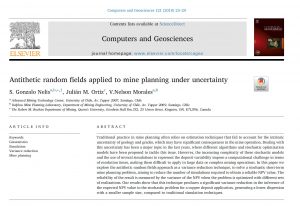 This paper was recently published in Computers & Geosciences.
This paper was recently published in Computers & Geosciences.
Click here to download.
Gonzalo Nelis (Advanced Mining Technology Center, University of Chile, Av. Tupper 2007, Santiago, Chile / Delphos Mine Planning Laboratory, Department of Mining Engineering, University of Chile, Av. Tupper 2069, Santiago, Chile), Julián M. Ortiz (The Robert M. Buchan Department of Mining, Queen’s University, Goodwin Hall Rm.332, 25 Union Street, Kingston, ON, K7L3N6, Canada), Nelson Morales (Advanced Mining Technology Center, University of Chile, Av. Tupper 2007, Santiago, Chile / Delphos Mine Planning Laboratory, Department of Mining Engineering, University of Chile, Av. Tupper 2069, Santiago, Chile)
Abstract
Traditional practice in mine planning often relies on estimation techniques that fail to account for the intrinsic uncertainty of geology and grades, which may have significant consequences in the mine operation. Dealing with this uncertainty has been a major topic in the last years, where different algorithms and stochastic optimization models have been proposed to tackle this issue. However, the increasing complexity of these stochastic models and the use of several simulations to represent the deposit variability impose a computational challenge in terms of resolution times, making them difficult to apply in large data or complex mining operations. In this paper we explore the antithetic random fields approach as a variance reduction technique, to solve a stochastic short-term mine planning problem, aiming to reduce the number of simulations required to obtain a reliable NPV value. The reliability of the result is measured by the variance of the NPV when the problem is optimized with different sets of realizations. Our results show that this technique produces a significant variance reduction in the inference of the expected NPV value in the stochastic problem for a copper deposit application, generating a lower dispersion with a smaller sample size, compared to traditional simulation techniques.
We are happy to announce that Sebastian Avalos received the 2018 Computers & Geosciences Research Scholarship, awarded for his research on Multiple-Point Simulation: A Recursive Convolutional Neural Networks approach.
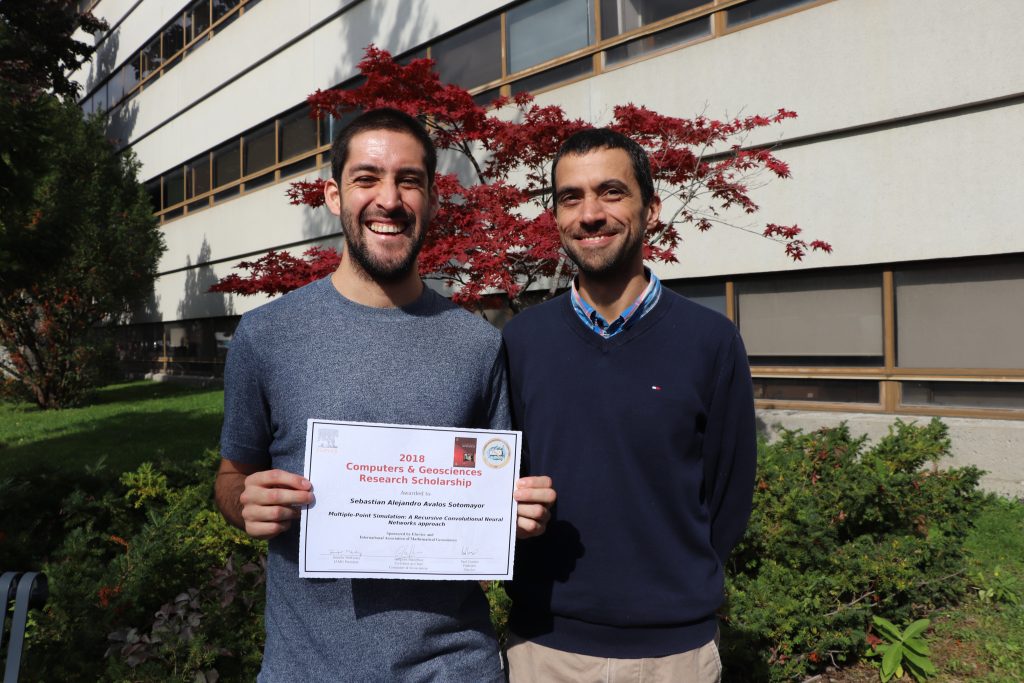
Congratulations Sebastian!
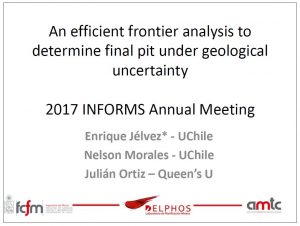 This work was presented at the INFORMS Annual Meeting 2017 in Houston, TX.
This work was presented at the INFORMS Annual Meeting 2017 in Houston, TX.
You can download the presentation Informs2017_talk.
[su_divider]
Enrique Jélvez (Delphos Mine Planning Lab – AMTC – Department of Mining Engineering, University of Chile), Nelson Morales (Delphos Mine Planning Lab – AMTC – Department of Mining Engineering, University of Chile), Julián Ortiz (The Robert M. Buchan Department of Mining, Queen’s University)
ABSTRACT
The final pit problem consists of finding the set of blocks that maximizes the undiscounted value of exploitation subject to precedence constraints. Although there exist efficient algorithms to compute it in a deterministic setting, the information on which this decision is made is subject to uncertainty. In this work, we present a comparison of several options to calculate final pit, including geological uncertainty given by a number of conditional simulations. In particular, we develop a model that allows us to generate the efficient frontier of final pit alternatives in the expected return-risk context, when the risk is measured in terms of Conditional Value at Risk.
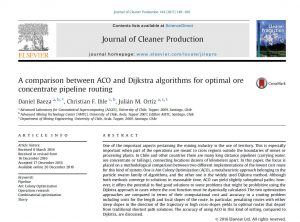 This paper was recently published in the Journal of Cleaner Production.
This paper was recently published in the Journal of Cleaner Production.
You can find it here.
[su_divider]
Daniel Baeza (Advanced Laboratory for Geostatistical Supercomputing (ALGES), University of Chile, Tupper, 2069, Santiago, Chile; Advanced Mining Technology Center (AMTC), University of Chile, Avda. Tupper 2007, Edificio AMTC, Santiago, Chile), Christian F. Ihle (Department of Mining Engineering, University of Chile, Avda. Tupper, 2069, Santiago, Chile; Advanced Mining Technology Center (AMTC), University of Chile, Avda. Tupper 2007, Edificio AMTC, Santiago, Chile), Julian M. Ortiz (Advanced Laboratory for Geostatistical Supercomputing (ALGES), University of Chile, Tupper, 2069, Santiago, Chile; Department of Mining Engineering, University of Chile, Avda. Tupper, 2069, Santiago, Chile)
Abstract
One of the important aspects pertaining the mining industry is the use of territory. This is especially important when part of the operations are meant to cross regions outside the boundaries of mines or processing plants. In Chile and other countries there are many long distance pipelines (carrying water, ore concentrate or tailings), connecting locations dozens of kilometers apart. In this paper, the focus is placed on a methodological comparison between two different implementations of the lowest cost route for this kind of system. One is Ant Colony Optimization (ACO), a metaheuristic approach belonging to the
particle swarm family of algorithms, and the other one is the widely used Dijkstra method. Although both methods converge to solutions in reasonable time, ACO can yield slightly suboptimal paths; however, it offers the potential to find good solutions to some problems that might be prohibitive using the
Dijkstra approach in cases where the cost function must be dyamically calculated. The two optimization approaches are compared in terms of their computational cost and accuracy in a routing problem including costs for the length and local slopes of the route. In particular, penalizing routes with either
steep slopes in the direction of the trajectory or high cross-slopes yields to optimal routes that depart from traditional shortest path solutions. The accuracy of using ACO in this kind of setting, compared to Dijkstra, are discussed.
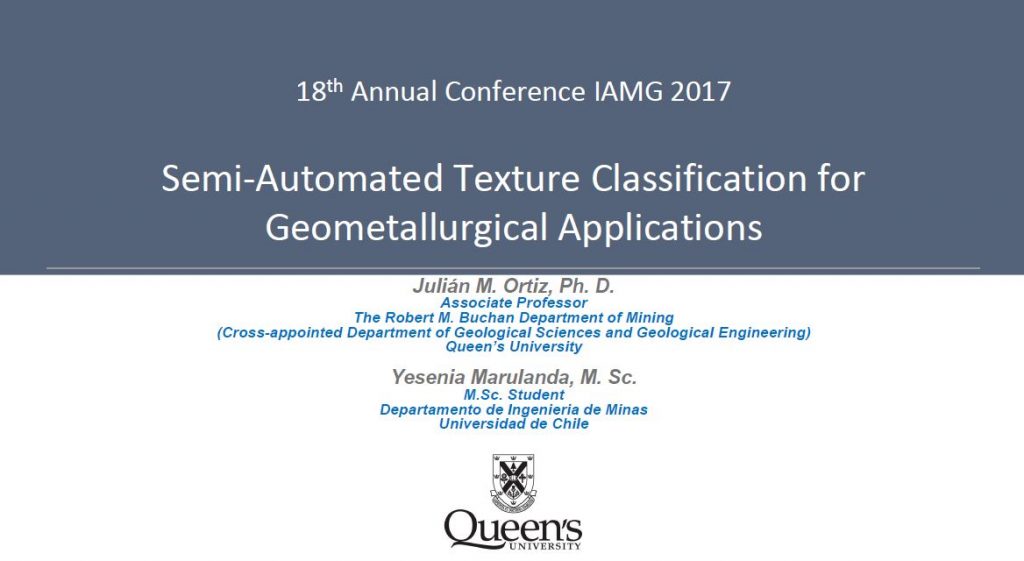 This work was presented at the 18th Annual Conference of the International Association of Mathematical Geosciences – IAMG 2017, in Perth, WA, Australia.
This work was presented at the 18th Annual Conference of the International Association of Mathematical Geosciences – IAMG 2017, in Perth, WA, Australia.
You can see the presentation 2017-09-07-IAMG-Textures.
[su_divider]
Semi-automated texture classification for geometallurgical applications
Julian M. Ortiz (julian.ortiz@queensu.ca) – Associate Professor, Robert M. Buchan Department of Mining, Queen’s University
Yesenia Marulanda (lymarulanda@gmail.com) – M.Sc. in Mining Engineering, Advanced Mining Technology Center, Department of Mining Engineering, Universidad de Chile
Abstract
Geological logging of drillholes usually comprises labeling mineralization zone, alteration type and lithology. Rock texture may be an important feature to complement this information, since texture is often related to the formation stage of the rock and is linked to the rock performance when subject to mining and metallurgical processes. Textures could be used in defining the geometallurgical domains.
We present progress towards semi-automatic texture characterization developed with different image and signal analysis techniques. A pilot test done over high resolution photographic records of drill cores from a porphyry copper deposit, shows that a high rate of correct classification of the textures can be achieved with automated techniques. Training of the algorithms requires a supervised labelling of some reference textures in a number of samples.
The pilot testing proceeded as follows: classification algorithms were developed using a reference library of textures (rock images and labels) of limited size (16 images for 6 classes, for a total of 96 images). The classification approach was then applied to a set of almost 14,000 unlabeled photographs accounting for 150 m of drill hole. The classification was compared with new labels done by geologists for 328 photographs. Some pre-processing techniques over the images were suggested and applied, and classification was repeated, increasing the performance.
Final results indicate that classification match over 70% of the logged textures by the geologists. This indicate that the drillhole information could be populated with texture classes from the photographs at a relatively low cost, adding a layer of information to the definition of geometallurgical units.

 We will be presenting at the 12th Conference on Geostatistics for Environmental Applications – Geoenv 2018, in Belfast,
We will be presenting at the 12th Conference on Geostatistics for Environmental Applications – Geoenv 2018, in Belfast,
Integrating uncertainty in rock hardness and solar irradiation in the optimization of a SAG mill energy system
Julian M. Ortiz – Robert M. Buchan Department of Mining, Queen’s University
Willy Kracht – Department of Mining Engineering / AMTC, Universidad de Chile
Giovanni Pamparana – Department of Mining Engineering / AMTC, Universidad de Chile
Jannik Haas – Energy Center, U. de Chile / D. of Stochastic Sim. and Safety Research, University of Stuttgart
Abstract
In mining, one of the most energy-intensive activities is the grinding of the rock, prior to the concentration processing. Peaks in energy consumption are severely penalized in electrical contracts, hence the use of alternative energy sources can help optimizing the energy cost.
In this paper, we use geostatistical simulations to characterize the in situ variability of rock hardness, to build a geometallurgical model of realistic feed to the Semi Autogenous (SAG) mill. The hardness is linked to the SAG’s energy consumption, which is optimized by means of the use of an integrated photovoltaic-battery energy storage system (PV-BESS) with backup from the power grid. We show a sizing methodology to determine the optimum size of the PV-BESS system, which combined with the power grid minimizes the total energy cost. Furthermore, several sensitivities over the mill’s feed are performed. To account for the variability in the energy available from the PV-BESS system, solar irradiation is simulated from historical data using a Markov chain approach.
Results show that the PV-BESS system can help reducing the energy consumption from the grid, and have a significant impact in avoiding peak requirements that are costly. Furthermore, we propose a demand side management (DSM) option, where the SAG feed is optimized by drawing from two stockpiles of rock with different hardness. In all scenarios tested, the PV-BESS option proves convenient, reducing the overall energy costs in over 30%. The uncertainty in rock hardness and the variability in solar irradiation have a direct effect on the sizing decisions.
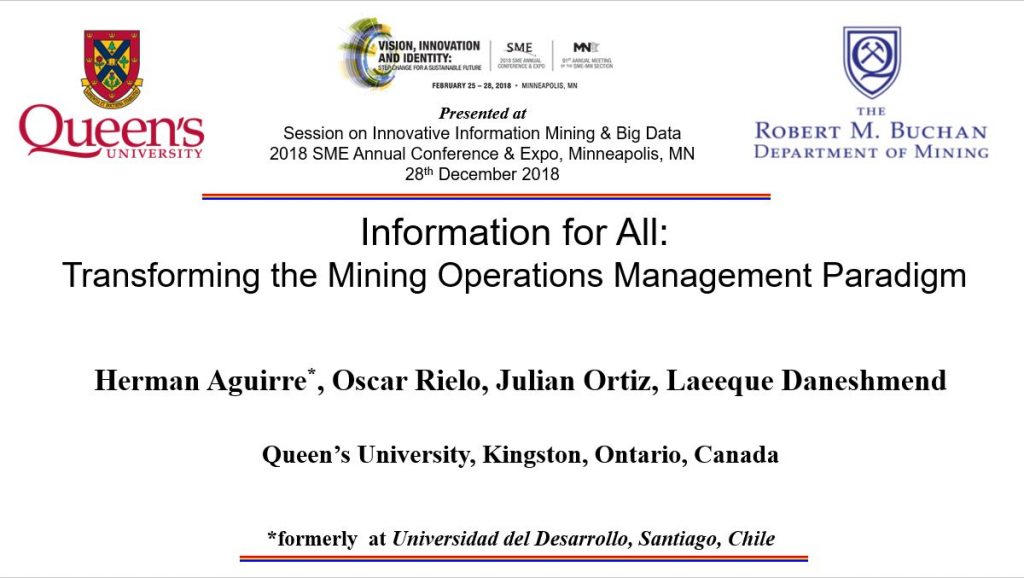 This presentation was prepared for the SME 2018 Annual Conference & Expo held in Minneapolis, MN, February 25-28, 2018.
This presentation was prepared for the SME 2018 Annual Conference & Expo held in Minneapolis, MN, February 25-28, 2018.
See presentation: 2018_02_28 SME Presentation.
Abstract
Four decades ago, the deployment of the first computerised fleet management systems in open pit mines led to a transformation in the management of mining operations. The enabling technologies underlying such systems have advanced radically, and dropped dramatically in terms of cost, however the capabilities of the resulting systems have only increased marginally, and they still tend to be limited to larger mines.
This paper outlines a novel technological paradigm for mine operations management based on adoption of nonproprietary Open Systems Architectures, and use of Commercial Off The Shelf elements, for both hardware and software. This paradigm lowers unit costs for deployed hardware and software by up to two orders of magnitude, minimises the need for technical expertise at mine sites, and transfers data analytics to the cloud. It makes the adoption of mine operations management systems feasible for a much wider range of mine sites, including small and medium sized operations, enabling the development of a highly competitive global marketplace in customised data analytics with the potential for significant enhancements in reporting and analysis capabilities, at reduced cost.
 The research paper “A path-level exact parallelization strategy for sequential simulation” by Oscar F. Peredo (Computer Architecture Department, UPC-BarcelonaTech, Spain; Telefonica I+D, Chile), Daniel Baeza (Advanced Laboratory for Geostatistical Supercomputing, University of Chile, Chile), Julian M. Ortiz (The Robert M. Buchan Department of Mining, Queen’s University, Canada), and Jose R. Herrero (Computer Architecture Department, UPC-BarcelonaTech, Spain) was recently published in Computers & Geosciences.
The research paper “A path-level exact parallelization strategy for sequential simulation” by Oscar F. Peredo (Computer Architecture Department, UPC-BarcelonaTech, Spain; Telefonica I+D, Chile), Daniel Baeza (Advanced Laboratory for Geostatistical Supercomputing, University of Chile, Chile), Julian M. Ortiz (The Robert M. Buchan Department of Mining, Queen’s University, Canada), and Jose R. Herrero (Computer Architecture Department, UPC-BarcelonaTech, Spain) was recently published in Computers & Geosciences.
You can find it here.
Abstract
Sequential Simulation is a well known method in geostatistical modelling. Following the Bayesian approach for simulation of conditionally dependent random events, Sequential Indicator Simulation (SIS) method draws simulated values for K categories (categorical case) or classes defined by K different thresholds (continuous case). Similarly, Sequential Gaussian Simulation (SGS) method draws simulated values from a multivariate Gaussian field. In this work, a path-level approach to parallelize SIS and SGS methods is presented. A first stage of re-arrangement of the simulation path is performed, followed by a second stage of parallel simulation for nonconflicting nodes. A key advantage of the proposed parallelization method is to generate identical realizations as with the original non-parallelized methods. Case studies are presented using two sequential simulation codes from GSLIB: SISIM and SGSIM. Execution time and speedup results are shown for large-scale domains, with many categories and maximum kriging neighbours in each case, achieving high speedup results in the best scenarios using 16 threads of execution in a single machine.